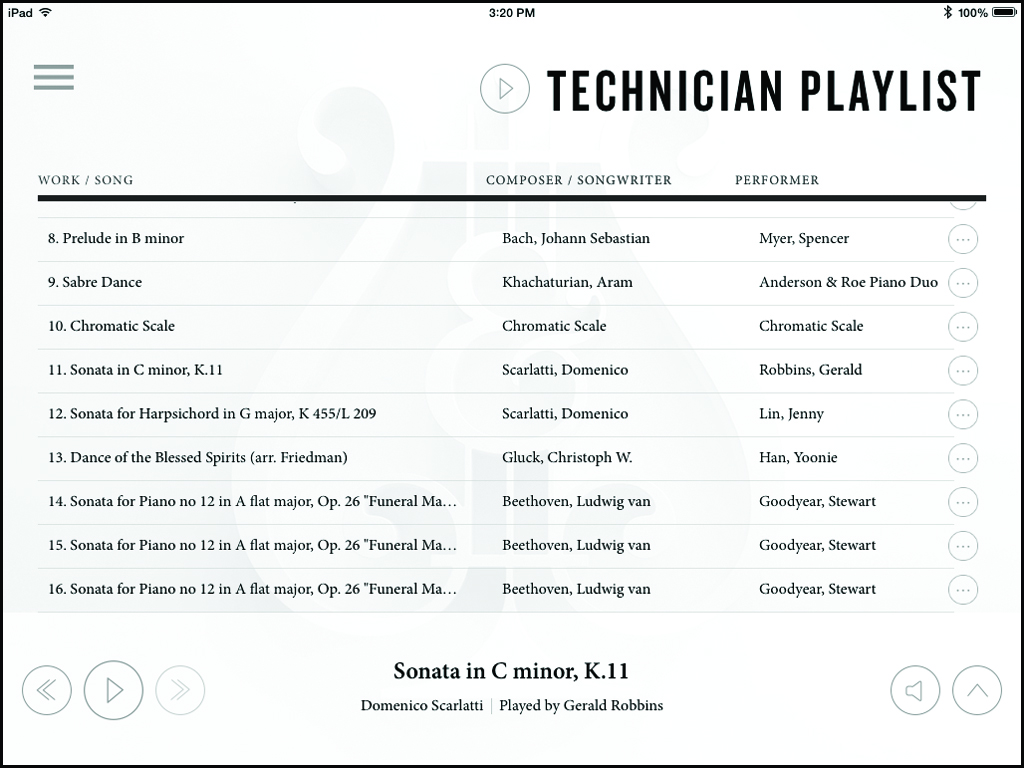The Technician version of the Spirio App comes with a playlist of music that is used to check the Spirio performance. The following songs are included and a brief description of their function is explained below

1. Goldberg Variations, BWV 988: Variation 5
a. Play at Full Dynamic Range to check the performance of the Spirio and listen for noises, clicks, buzzes etc.
b. Play at Quiet Play to verify that all the notes speak
2. Flight of the Bumblebee
a. Play at Full Dynamic Range to check the performance of the Spirio and listen for noises, clicks, buzzes etc.
b. Play at Quiet Play to verify that all the notes speak
3. “Appassionata” Sonata: I. Allegro assai
a. Play at Quiet Play dynamic range. At about 29 seconds into the piece, C# (note 17) is played three times followed by C (note 16). If any of the three C#’s are not audible, the Global Even Play is too low and must be increased.
4. Mazurka in A at major, Op. Posth.
a. Play at Full Dynamic Range to check the Loud Pedal Calibration (LPCAL).
b. About 7 seconds into the piece, the series of chords that play should not “bleed” into one another.
5. I’m Beginning to See the Light
a. Play at Full Dynamic Range to check the shift pedal calibration (SPCAL).
b. While the song is playing, press on the le pedal to see that there is about 0.5mm of free play between the keyframe and the keyframe stop screw.
c. Listen to the voicing to see if the shift pedal voicing needs adjustment.
6. Nocturne for Piano no 5 in B at major, H37
a. Play at Full Dynamic Range to check subtle differences in the soft playback.
b. Play at Quiet Play to check that all notes still speak
7. Sonata in C minor, K.11
a. Play at Full Dynamic Range to check Global Even Play.
b. Listen to the first 30 seconds of the piece. There should be a marked contrast (but not too great a contrast) between the phrase that begins at 13 seconds and its “echo” (softer repeat) that starts at 16 seconds. This behavior should appear again with the phrase that begins at 19 seconds and its echo that starts at 21 seconds.
c. If there is no contrast between the phrases then the Global Even Play is too high and needs to be lowered.
8. Sonata for Harpsichord in G major, K 455/L 209
a. Play at Full Dynamic Range and Quiet Play to check action regulation, key upstop rail height and overall keyboard calibration.
b. At 23 seconds, A4 (note #49) begins to repeat. Check to hear good repetition at both Full Dynamic Range and Quiet Play
c. At minute 1:41, note E4 (note #44) begins to repeat. Check to hear good repetition at both Full Dynamic Range and Quiet Play
9. Clair de lune
a. Play at Full Dynamic Range to test LP Calibration
b. Listen to the first 30 seconds of the piece. If it sounds too “dry”, the LP solenoid black pusher tip needs to be lowered.
c. Run LPCAL. While the solenoid is being held at the Damper Contact Point increase the ring-through time.
10. Dance of the Blessed Spirits
a. This piece is played very softly and is a great check of the overall voicing of the piano.
11. April in Paris
a. At 2 minutes into the piece, listen to the damper release sound as a way to test for excess damper noise.
12. Waltz, Op. 64: No. 1 in D flat major “Minute Waltz”
a. Play at Quiet Play to check shift pedal calibration (SPCAL)
b. At about 20 seconds into the piece sure there is no “thumping” shift pedal release sound.
13. Soft Play Test
a. Play at Full Dynamic Range to test for evenness of volume.
b. Use Even Play adjustment in Keyboard Adjust Mode to correct any notes that are too loud or too soft
14. Repetition Test
a. Use this test during the initial setup of the instrument to do a final check of the regulation parameters and keyboard calibration
b. If notes drop or don’t repeat, check for regulation or action friction issues
You can create your own customized playlist using the Add to Playlist feature of the App.